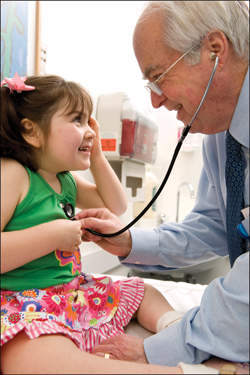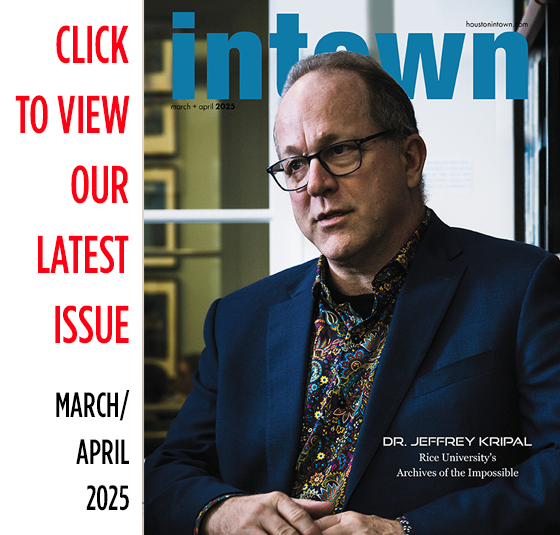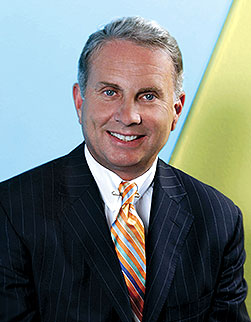
An Interview with CEO powerhouse Mark A. Wallace.
In 1989, at the age of 36, Mark A. Wallace was appointed President and CEO of Texas Children’s Hospital, which treats in excess of 2 million children annually and is consistently ranked among the best pediatric hospitals in the nation.
He has directed the completion of two capital expansion projects, one totaling $149 million in facilities development [to add one million square feet] and an accompanying capital campaign of $67.5 million in 1991, and one totaling $345 million [to add 1.2 million square feet and increase the hospital’s bed capacity from 456 to 639] with an accompanying capital campaign of $80 million] in 2001. Currently, he leads Vision 2010, a third capital expansion project due for completion in early 2012 totaling $1.5 billion [including Texas Children’s Pavilion for Women, Texas Children’s Jan and Dan Duncan Neurological Research Institute, Texas Children’s Hospital West Campus and expansion of the existing Feigin Research Center [adding 2 million square feet of space] and an accompanying capital campaign of $400 million. Prior to his appointment at Texas Children’s, Mark was a
Senior Vice President at The Methodist Hospital in Houston.
Honors and awards include: the ACHE Robert S. Hudgens Memorial Award as the “Young Healthcare Executive of the Year” (1992); the Texas Hospital Association Earl M. Collier Award for Distinguished Healthcare Administration (2005); Washington University School of Medicine Health Administration Program’s Distinguished Alumnus Award (2006); Texas Pediatric Society’s Distinguished Service Award in (2010); and the Bo’s Place Houston Robin Bush Award (2011).
Mark holds degrees from Oklahoma Baptist University and Washington University in St. Louis. He is married to Shannon, and they have two children and four grandsons.
An Interview with Mark A. Wallace
What is the primary function of Texas Children’s Hospital and how did it all begin?
It all began in 1954 with the vision of Mr. Jim Abercrombie and Mr. Leopold Meyer in the 40’s and 50’s with our city’s leaders and the Texas Medical Center knowing Houston was going to grow very rapidly and they all wanted a great facility. One of the most important decisions they made was in the name. They decided on Texas Children’s Hospital, not Houston Children’s Hospital. So, even today, it serves all parts of Texas, the United States and the world. Every year, we take care of children from all 50 states and from 70 different countries.
You were elected president of the Texas Children’s Hospital at the ripe old age of thirty six. What in your background do you attribute to this rapid advancement?
I have wanted to be a CEO at a hospital since I was sixteen years of age. I grew up in Oklahoma City and in 1966 there were not that many formally trained hospital CEO’s in America. The people that ran hospitals in America were mostly nuns out of the Catholic system and other church denominations such as the Baptist, Methodist, and Episcopal hospitals. The field had not fully developed in those days. I was reading some career journals about the future of health care and hospitals and they were very bullish about the opportunities in the medical and healthcare sectors because Medicaid and Medicare legislation had just been passed in 1965 and enacted in 1966. The growth was to occur in hospitals and it was going to be a tremendous growth story. I also knew I wanted to major in business when I went to college and I knew that someday I wanted to get my masters, but at the age of sixteen in 1968, I felt I was destined to become a hospital CEO.
What really got me ready to take that step at the age of thirty six was going to graduate school at Washington University in St. Louis and getting my Masters in health administration and, following that, having the great opportunity in 1977 to do my hospital administrator fellowship at The Methodist Hospital in Houston. In March of 1978 they asked me to stay on and be an assistant vice president. Two years later I was promoted to a vice president at the age of 26 and a senior vice president at 30. So I grew up in the Texas Medical Center at Methodist Hospital under the great leadership and mentoring of people like Ted Bowen, who was president of Methodist Hospital at the time, and later on, Ron Girotto, who is the current president and CEO. Also, preceding Ron was Larry Mathis, so I had great role models. It was a very rich leadership development environment and culture at The Methodist Hospital. At the time, Methodist Hospital was also the private primary adult teaching hospital for Baylor College of Medicine. It was then that I really developed a passion and my understanding for how a hospital relates to its medical school academic partner. I got to know the majority of the faculty and that helped prepare me for coming to the Texas Children’s Hospital in 1989.
Also at that time, I was working with Dr. Ralph Feigin, who was physician-in-chief at Texas Children’s and the chairman of the pediatrics department at Baylor College of Medicine.
So I would have to point to the Methodist Hospital and the great opportunity early on in my career to become a better leader and to really develop an in-depth understanding of how teaching hospitals relate to their academic partners and create great programs in patient care in education and in research.
What is the one thing or the spark that led Texas Children’s to become the hospital it is today?
I think it was the unique relationship between Dr. Ralph Feigin, me, the board, medical staff and the employees. The thing that really helped serve as the catalyst was the paired leadership model that we had begun in 1989 at Texas Children’s. Dr. Feigin and I began building a medical staff and management team. Dr. Feigin was brilliant and was passionate around academic medicine, quality, and particularly around taking care of sick children and families that
needed and required the unique healthcare services of an organization like Texas Children’s Hospital. Dr. Feigin and I were always on the same page. We really never had a major disagreement about where we wanted to take Texas
Children’s. One of the fortuitous things about it was that Dr. Feigin and I already knew each other because, coincidentally, he came to the Texas Medical Center also from Washington University in the same year I came to Methodist Hospital.
For twelve years we had known each other and he said if you will come over and be the CEO, you and I together, with the support of the board, the medical staff, our employees and, of course, the community, we can make Texas Children’s one of the preeminent children’s hospitals in the United States. I think that was the major turning point in the history of Texas Children’s Hospital. The great Dr. Ralph Feigin coming together with me and being on the same page, and building a team with a great example of executive and physician leadership coming together and truly creating transformational change and performance.
What is the largest percentage of your patients here for?
Being one of the largest children’s hospitals, the majority of our programs and services are very large. Our cancer center is the largest pediatric cancer center in the U.S. If you look at our newborn center and our neonatal service section, where we take care of the sickest of the sick newborns and also house the largest newborn nursery in the U.S., we currently have 131 of our 467 beds dedicated just to neonatology. If you look at the largest service, it is taking care of neonates. We have been well known since the seventies for taking care of premature and low birth rate infants, when hospitals first invented the concept of a neonatal intensive care unit. Our cancer center and our heart center are some of the largest in the U.S. Led by Dr. Chuck Fraser and Dr. Dan Penny, our Heart Center does over 1000 congenital heart surgeries annually. Those patients that come to us travel some of the greatest distances for treatment. Cancer, heart, newborns, and the diabetes programs are large but the most common diagnosis for a child at Texas Children’s is an admission for a pulmonary problem such as asthma, or some respiratory infection, which is pretty typical of most children’s hospitals. But, the profile of the children we take care of is a little different, mostly due to the acuity and caring for the sickest of the sick.
How do you decide where to spend your money and on what research projects do you focus?
That is a really good question. Because we all live in a world of finite and limited resources, we have to be very specific and myopic in terms of when we want to deploy resources, whether it is for patient care, education or research programs. We focus on our largest services like our cancer center, heart center, or newborn center and now our neurosciences area.The area of neuroscience is gaining a lot of attention since, unfortunately, there are about 14 million children in the U.S. that have a neurological disorder such as autistic spectrum disorder, down syndrome or cerebral palsy, which is why we are investing a lot in this type of research. Basic science, translational and clinical research is behind the reason for forming the first comprehensive pediatric neurological research institute in the U.S., the Jan and Dan Duncan Neurological Research Institute at Texas Children’s Hospital. Because of all these daunting and complex neurological problems, children from around the world come here for treatment, and we don’t cure any of them. We treat their symptoms, but we can’t cure the diseases they have. For instance, along the autistic spectrum disorder, there
is an array of problems we want to find a cure for. Because we are not curing but caring for these sick children, we want to put our research dollars into focusing on accelerating what we are doing in the basic sciences so we can some day find cures for those children and their families.
What is your relationship with the Baylor College of Medicine and St. Luke’s Episcopal Hospital?
The relationship with the Baylor College of Medicine is a spectacular one. Texas Children’s is really Baylor College of Medicine and Baylor College of Medicine is really Texas Children’s Hospital. We are conjoined twins at the hip, and it is
important that we remain one of the top children’s hospitals and Baylor remains one of the top medical schools. Also, now with the addition of the new Texas Children’s Pavilion for Women, we now can be a top institute for maternal/fetal medicine, infertility, maternal/fetal surgery, fetal intervention, obstetrics and in vitro fertilization. St. Luke’s Episcopal Hospital and Texas Children’s were started at the same time. We are able to do what we do because of our relationship with St. Luke’s and an agreement signed six years ago that delegated to us all the OB/GYN and maternal fetal medicine programs for women and let us run that service for them. We have a great admiration and respect for St. Luke’s and their medical staff, particularly in cardiology through the Texas Heart Institute.
Texas Children’s has a Star product and a CHIP program for children. How do these programs work?
If you look at the average child at Texas Children’s, the majority are covered by Medicaid or the CHIP program (Children Hospital Insurance Program). In Texas, earning an annual income of up to $18,000 a year enables a family to qualify for Medicaid. About 45% of our patients are covered by Medicaid and about 3.5% by the CHIP program. Most of the children we take care of are poor and many from single parent homes, and this provides a unique challenge, one that we really embrace. We want to make sure we are a home and place of destination for all children regardless of their ability to pay. People ask me all the time if I am worried about the reimbursement levels of Texas Children’s patients due to so many being covered by Medicaid and CHIP. We are always hearing about declining Medicaid and CHIP program payments, but I am not worried about that because one of our founding principles and guidelines of
Texas Children’s Hospital has always been to take care of children regardless of their ability to pay. The more children we are able to take care of the better we tend to do in raising money through great support from the Houston community. My goal has always been to do the right thing for children. The right thing is always to take care of that child in need and worry about how that works out financially later on, and it always has worked out.
How has the healthcare bill affected your hospital and what changes do you see in the industry overall?
We don’t know. There is a tremendous amount of doubt and uncertainty in medicine and in healthcare throughout the U.S. I am not sure that our government and Congress understands the impact of the healthcare reform act. We do know we are going to have to do more with less in the future. Currently, we have about 2.5 million patient encounters per year at Texas Children’s, and over the next 20 years the child population is expected to grow by almost a third. We also have to continue to grow. We know that the volume is going to continue to grow and reimbursements are probably going to decline. The challenge is to find ways to enhance productivity and do more with less.
What can you tell us about the new Texas Children’s Pavilion for Women?
It is one of the most exciting initiatives we have had in some time. We are expanding into obstetrics and gynecology with the goal of getting better outcomes for healthier children through better prenatal care. What better way to take care of mom by combining women’s services next door to the Texas Children’s Hospital. Trying and getting the very best outcome for a newborn by specializing in prenatal care, as well as having so many pediatric specialists available through Texas Children’s once a child has been born, is our ultimate goal.
I hear you are putting a stronger focus on the surgical programs at Texas Children’s. Tell me a little bit about that?
Texas Children’s surgical enterprise is directed by newly appointed Surgeonin- Chief Charles D. Fraser, Jr., M.D., whose vision is to build on the hospital’s multidisciplinary strength as an educational and research leader for pediatric surgery and to grow that reputation nationally and globally. Last year, surgeons at Texas Children’s Hospital performed more than 22,000 procedures, ranging from routine outpatient operations to complex interventions on children with unique surgical problems. We have more than 100 surgeons representing multiple pediatric surgical subspecialties, and the hospital’s surgical service is known for its particularly excellent outcomes with complex surgeries, its creativity and its renowned multi-disciplinary strength and, again, as an educational and research leader for pediatric surgery. There are many, many pieces to put together when it comes to pediatric surgery—whether it’s a “simple” tonsillectomy or a potentially lifesaving transplant. But with all the intricacies involved, we never forget who our patients are. They are children, and children are not simply small adults. Pediatric surgical needs and requirements are different, and we strive to meet those needs and fulfill those requirements in every way.
One in six jobs in America is in the healthcare sector. Biotechnology and big pharmacy companies overall are doing well. Companies such as Amgen and Johnson & Johnson as well as Stryker, who makes hospital beds, are all doing well. We are adding 2.5 million feet of space and are still hiring but we will still have to be cautious. Critical care and nurses are still in high demand as there is a shortage of these people. We are aggressively recruiting people in these areas. I think there is a tremendous opportunity for young people in Houston in the medical field and specifically in the Texas Medical Center.
You have had a lot of accomplishments. What are you most proud of?
Personally, hopefully, being a good husband and dad and now granddad. I have had a very blessed career at Texas Children’s and also a great family with my wife Shannon and two children, Ben and Emily, now our four grandchildren
and a great mom and dad who are still with us. Hopefully, I have been as good a leader in my family as I have been in my professional life. My foremost priority is and has been my family.
























